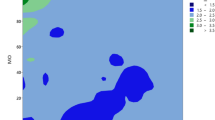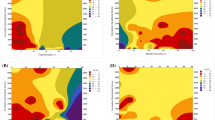Abstract
Estimating hydraulic properties of carbonate is challenging due to its wider range of porosity and complex pore structures. To investigate the hydraulic properties of carbonate rocks, a novel approach inspired by quantum genetic optimization in this work is proposed to extract the optimal pore network model (PNM), which is applied to simulate the hydraulic properties. The pore network variables, such as porosity, pore and throat sizes, are considered as the optimal parameters, and the capillary pressure curve, breakthrough drainage pressure and permeability are calculated based on the constructed PNM. The computing time (CPU time) and memory usage (RAM usage) for the PNM extraction using the proposed approach and classical methods are compared. Results indicate that the proposed approach shows better computing efficiency than classical methods. Excellent agreements are found between the experimental and simulation results from the proposed and classical methods. The proposed approach provides promising tools to investigate the hydraulic properties of geomaterials.










Similar content being viewed by others
References
Al-Kharusi A, Blunt MJ (2007) Network extraction from sandstone and carbonate pore space images. J Pet Sci Eng 56:219–231
Al-Raoush RI, Willson CS (2005) Extraction of physically realistic pore network properties from three-dimensional synchrotron X-ray microtomography images of unconsolidated porous media systems. J Hydrol 300(1):44–64
An S, Yao J, Yang Y, Zhang L, Zhao J, Gao Y (2016) Influence of pore structure parameters on flow characteristics based on a digital rock and the pore network model. J Nat Gas Sci Eng 31:156–163
Bai H, Ge Y, Mariethoz G (2016) Utilizing spatial association analysis to determine the number of multiple grids for multiple-point statistics. Spat Stat 17(17):83–104
Biswal B, Manwart C, Hilfer R, Bakke S, Øren PE (1999) Quantitative analysis of experimental and synthetic microstructures for sedimentary rock. Physica A 273(3–4):452–475
Chen F, Xiong H, Wang X, Yin ZY (2023) Transmission effect of eroded particles in suffusion using the CFD-DEM coupling method. Acta Geotech 18:335–354
Chen XL, Liu J, Yu C, Wang S, Wu W (2023) Analytical solutions to thermal gradient enhanced diffusion of organic contaminants through unsaturated composite liner: considering the existence of capillary fringe. Acta Geotech 18(9):1–20
Collins RE (1961) Flow of fluids through porous materials. Reinhold Pub, New York
Dudek G (2004) Unit commitment by genetic algorithm with specialized search operators. Electr Power Syst Res 72(3):299–308
Dullien FA (1992) Porous media: fluid transport and pore structure, 2nd edn. Harcourt Brace, Academic, San Diego
Durr C, Hoyer P (1996) A quantum algorithm for finding the minimum. arXiv preprint arXiv:quant-ph/9607014
Dong H, Blunt MJ (2009) Pore-network extraction from micro computerized tomography images. Phys Rev E 80:036307
Han KH, Kim JH (2002) Genetic quantum algorithm and its application to combinatorial optimization problem. Evolut Comput 2000 Proc Congr IEEE 2:1354–1360
Hinebaugh J, Bazylak A (2010) Condensation in PEM fuel cell gas diffusion layers: a pore network modeling approach. J Electrochem Soc 157:1382–1390
Huang T, Li X, Zhang T, Lu DT (2013) Gpu-accelerated direct sampling method for multiple-point statistical simulation. Comput Geosci 57(57):13–23
Ketcham RA, Carlson WD (2001) Acquisition, optimization and interpretation of X-ray computed tomographic imagery: applications to the geosciences. Comput Geosci 27(4):381–400
Khishvand M, Akbarabadi M, Piri M (2016) Micro-scale experimental investigation of the effect of flow rate on trapping in sandstone and carbonate rock samples. Adv Water Resour 94:379–399
Krzaczek M, Nitka M, Tejchman J (2023) A novel DEM-based pore-scale thermal-hydro-mechanical model for fractured non-saturated porous materials. Acta Geotech 18:2487–2512
Lindquist WB, Sang-Moon L, Coker DA, Jones KW, Spanne P (1996) Medial axis analysis of void structure in three-dimensional tomographic images of porous media. J Geophys Res 101:8297–8310
Li P, Li S (2008) Quantum-inspired evolutionary algorithm for continuous space optimization based on bloch coordinates of qubits. Neurocomputing 72(1):581–591
Liu Y, Jeng DS, Xie H, Li CB (2023) On the particle morphology characterization of granular geomaterials. Acta Geotech 18:2321–2347. https://doi.org/10.1007/s11440-022-01733-z
McCabe WL (2005) Unit operations of chemical engineering, 7th edn. McGraw-Hill, New York
Malossini A, Blanzieri E, Calarco T (2008) Quantum genetic optimization. IEEE Trans Evol Comput 12(2):231–241
Moaddel A, Müter D, Gooya R, Sørensen HO, Stipp SLS (2018) A fuzzy logic based algorithm for defining and extracting pore network structure from tomography images of rocks. Adv Water Resour 119:197–209
Nielsen MA, Chuang IL (2000) Quantum computation and quantum information. Cambridge University Press, Cambridge
Øren PE, Bakke S (2002) Process based reconstruction of sandstones and prediction of transport properties. Transp Porous Media 46(2–3):311–343
Patzek TW, Silin DB (2001) Shape factor and hydraulic conductance in noncircular capillaries: I. One-phase creeping flow. J Colloid Interface Sci 236:295–304
Rabbani A, Jamshidi S (2014) Specific surface and porosity relationship for sandstones for prediction of permeability. Int J Rock Mech Min Sci 71:25–32
Rabbani A, Assadi A, Kharrat R, Dashti N, Ayatollahi S (2017) Estimation of carbonates permeability using pore network parameters extracted from thin section images and comparison with experimental data. J Nat Gas Sci Eng 42:85–98
Rezanezhad F, Quinton WL, Price JS, Elrick D, Elliot TR, Heck RJ (2009) Examining the effect of pore size distribution and shape on flow through unsaturated peat using computed tomography. Hydrol Earth Syst Sci 13:1993–2002
Raoof A, Hassanizadeh SM (2012) A new formulation for pore-network modeling of two-phase flow. Water Resour Res 48:1–13
Sahimi M (2012) Flow and transport in porous media and fractured rock: from classical methods to modern approaches. Wiley
Scheperboer IC, Suiker ASJ, Bosco E, Clemens FHLR (2022) A coupled hydro-mechanical model for subsurface erosion with analyses of soil piping and void formation. Acta Geotech 17:4769–4798. https://doi.org/10.1007/s11440-022-01479-8
Silin D, Patzek T (2006) Pore space morphology analysis using maximal inscribed spheres. Phys A 371(2):336–360
Su D, Yan WM (2020) Prediction of 3D size and shape descriptors of irregular granular particles from projected 2D images. Acta Geotech 15:1533–1555. https://doi.org/10.1007/s11440-019-00845-3
Tengattini A, Andò E, Einav I, Viggiani G (2023) Micromechanically inspired investigation of cemented granular materials: part I–from X-ray micro tomography to measurable model variables. Acta Geotech 18:35–55. https://doi.org/10.1007/s11440-022-01486-9
Thovert JF, Salles J, Adler PM (2011) Computerized characterization of the geometry of real porous media: their discretization, analysis and interpretation. J Microsc 170(1):65–79
Vasilyev L, Raoof A, Nordbotten JM (2012) Effect of mean network coordination number on dispersivity characteristics. Transp Porous Media 95(2):447–463
Varloteaux C, Békri S, Adler PM (2013) Pore network modelling to determine the transport properties in presence of a reactive fluid: from pore to reservoir scale. Adv Water Resour 53(2):87–100
Wang J, Zhao J, Zhang Y, Wang D, Li Y, Song Y (2016) Analysis of the effect of particle size on permeability in hydrate-bearing porous media using pore network models combined with ct. Fuel 163:34–40
Wang JP, Luan JY, Gao XG, Liu TH, Ando E, Francois B (2022) A micro-investigation of unsaturated sand in mini-triaxial compression based on micro-CT image analysis. Acta Geotech 17:4799–4821. https://doi.org/10.1007/s11440-022-01658-7
Wang X, Zhang H, Yin ZY, Su D, Liu ZQ (2023) Deep-learning-enhanced model reconstruction of realistic 3D rock particles by intelligent video tracking of 2D random particle projections. Acta Geotech 18:1407–1430. https://doi.org/10.1007/s11440-022-01616-3
Wu Y, Lin C, Ren L, Yan W, An S, Chen B, Wang Y, Zhang X, You C, Zhang Y (2018) Reconstruction of 3D porous media using multiple-point statistics based on a 3D training image. J Nat Gas Sci Eng 51:129–140
Wildenschild D, Vaz CMP, Rivers ML, Rikard D, Christensen BSB (2002) Using x-ray computed tomography in hydrology: systems, resolutions, and limitations. J Hydrol 267(3):285–297
Xiao N, Zhou X, Ling T (2022) Novel cooling–solidification annealing reconstruction of rock models. Acta Geotech 17:1785–1802. https://doi.org/10.1007/s11440-021-01307-5
Xu L, Liu X, Liang L (2014) A pore network model reconstruction method via genetic algorithm. J Nat Gas Sci Eng 21:907–914
Xu WJ, Zhang HY (2022) Meso and macroscale mechanical behaviors of soil–rock mixtures. Acta Geotech 17:3765–3782. https://doi.org/10.1007/s11440-022-01449-0
Yang L, Ai L, Xue K, Ling Z, Li Y (2018) Analyzing the effects of inhomogeneity on the permeability of porous media containing methane hydrates through pore network models combined with CT observation. Energy 163:27–37
Zhao Y, Sun Y, Liu S, Chen Z, Yuan L (2018) Pore structure characterization of coal by synchrotron radiation nano-CT. Fuel 215:102–110
Zhao Z, Zhou XP, Qian QH (2020) Fracture characterization and permeability prediction by pore scale variables extracted from X-ray CT images of porous geomaterials. Sci China Technol Sci 63(5):755–767
Zhang T, Du Y, Huang T, Li X (2015) Gpu-accelerated 3d reconstruction of porous media using multiple-point statistics. Comput Geosci 19(1):1–20
Zhang X, Nowamooz H (2023) Mechanical degradation of unstabilized rammed earth URE wall under salts and rising damp attack effect. Acta Geotech 18:1–18
Acknowledgements
The authors would like to thank for the support of the National Natural Science Foundation of China (Nos. 42207193, 52027814, 51839009), the Natural Science Foundation of Hubei Province (2022CFB609), the Open Foundation of the Key Laboratory of Universities in Anhui Province for Prevention of Mine Geological Disasters (2022-MGDP-02) and the National Center for International Research on Deep Earth Drilling and5 Resource Development (DEDRD-2022-07).
Funding
National Natural Science Foundation of China, 42207193, Zhi Zhao, 52027814, Xiaoping Zhou, 51839009, Xiaoping Zhou, Natural Science Foundation of Hubei Province, 2022CFB609, Zhi Zhao, Open Foundation of the Key Laboratory of Universities in Anhui Province for Prevention of Mine Geological Disasters, 2022-MGDP-02, Zhi Zhao, National Center for International Research on Deep Earth Drilling and Resource Development, DEDRD-2022-07, Zhi Zhao
Author information
Authors and Affiliations
Contributions
Zhi Zhao was contributed writing–original drafts and codes; Yun-Dong Shou was involved in experiments and algorithms and Xiao-Ping Zhou was performed algorithms, review and editing.
Corresponding author
Ethics declarations
Conflict of interest
The authors declare that there are no competing financial interests.
Additional information
Publisher's Note
Springer Nature remains neutral with regard to jurisdictional claims in published maps and institutional affiliations.
Rights and permissions
Springer Nature or its licensor (e.g. a society or other partner) holds exclusive rights to this article under a publishing agreement with the author(s) or other rightsholder(s); author self-archiving of the accepted manuscript version of this article is solely governed by the terms of such publishing agreement and applicable law.
About this article
Cite this article
Zhao, Z., Shou, YD. & Zhou, XP. A novel digital extraction approach of pore network models from carbonates inspired by quantum genetic optimization techniques. Acta Geotech. (2024). https://doi.org/10.1007/s11440-024-02310-2
Received:
Accepted:
Published:
DOI: https://doi.org/10.1007/s11440-024-02310-2




